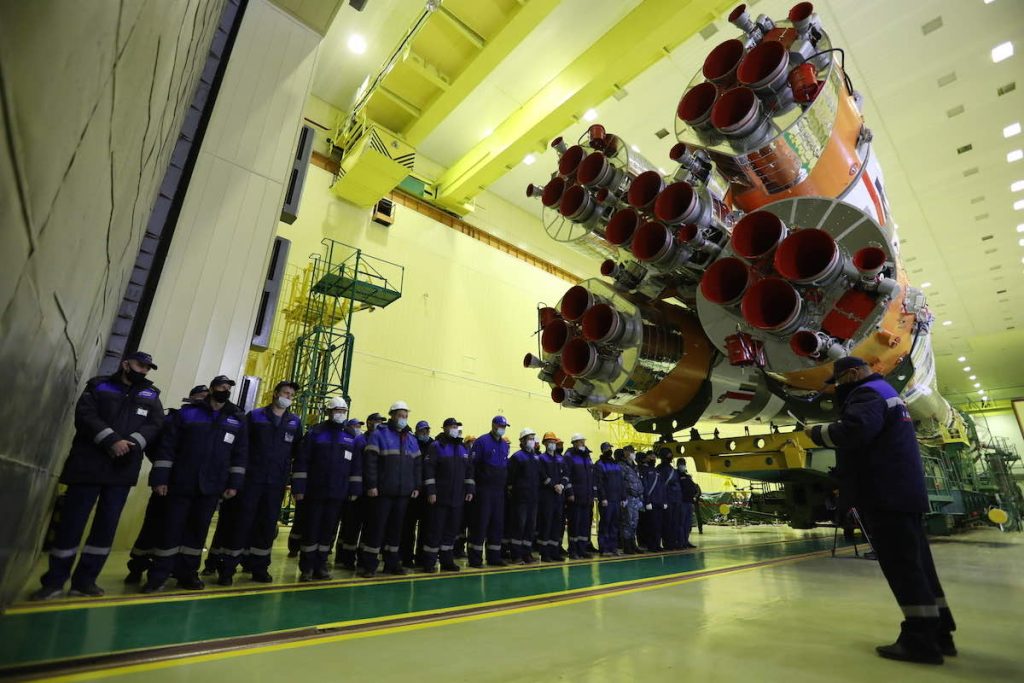
A Soyuz rocket rolled out to its launch pad in Kazakhstan Friday, ready to blast off Tuesday to the International Space Station with veteran Russian cosmonaut Anton Shkaplerov, actress Yulia Peresild, and film director Klim Shipenko.
The Soyuz-2.1a launcher, positioned on its side on a special railroad car, emerged from an integration building at the Baikonur Cosmodrome and rode to the Site 31 launch pad just after sunrise Friday.
After arriving at the launch complex, the rocket was raised vertical over the pad’s flame trench. Ground teams raised retractable service towers into position around the rocket, providing access to the vehicle for final preflight checkouts, and for the three-person crew set to ride the Soyuz into orbit Tuesday.
Russian teams will load kerosene and liquid oxygen propellants into the three-stage rocket in the final hours before launch.
Liftoff with the Soyuz MS-19 spacecraft Tuesday is set for 4:55:02 a.m. EDT (0855:02 GMT; 1:55:02 p.m. Baikonur time), kicking off a three-hour pursuit of the International Space Station.
Powered by nearly a million pounds of thrust, the Soyuz booster will arc downrange northeast from Baikonur, shedding its four strap-on liquid-fueled boosters about two missions into the mission. The rocket will jettison the aerodynamic fairing shielding the Soyuz MS-19 spacecraft, and the core stage will give way to a third stage to complete the job of placing the spaceship into orbit.
The spacecraft will separate from the third stage and begin maneuver to match the orbit of the space station, culminating in an automated docking to the outpost’s Rassvet module at 8:12 a.m. EDT (1212 GMT).
Shkaplerov, a veteran of three previous space station expeditions, has logged 533 days in orbit. He is beginning a nearly six-month mission set to last until late March.
Shipenko and Peresild will spend 11 days on the space station to film a Russian feature length movie titled “The Challenge.” During that time, 10 people will be living and working on-board the complex.
The two-person film crew will leave the station and return to Earth on Oct. 16 aboard the Soyuz MS-18 spacecraft with cosmonaut Oleg Novitskiy, who launched into orbit April 9. The Soyuz MS-18 spacecraft will parachute to a landing on the steppe of Kazakhstan.
The crewmates who launched with Novitskiy in April — NASA astronaut Mark Vande Hei and Russian flight engineer Pyotr Dubrov — had their missions extended to accommodate the Russian film crew. Vande Hei and Dubrov will spend nearly one year on the space station before returning to Earth with Shkaplerov on the Soyuz MS-19 spacecraft next March.
The Soyuz crew rotation will be followed later this month by the launch of a SpaceX Crew Dragon spacecraft Oct. 30 from Kennedy Space Center in Florida. The Crew Dragon will ferry NASA commander Raja Chari, pilot Thomas Marshburn, European Space Agency astronaut Matthias Maurer, and NASA mission specialist Kayla Barron to the space station.
Chari and his crewmates will replace an outgoing Dragon crew who launched in April. Commander Shane Kimbrough, pilot Megan McArthur, Japanese astronaut Akihiko Hoshide, and ESA astronaut Thomas Pesquet will return to Earth on SpaceX’s Crew Dragon Endeavour spacecraft in the first week of November, targeting a splashdown off the coast of Florida.





























